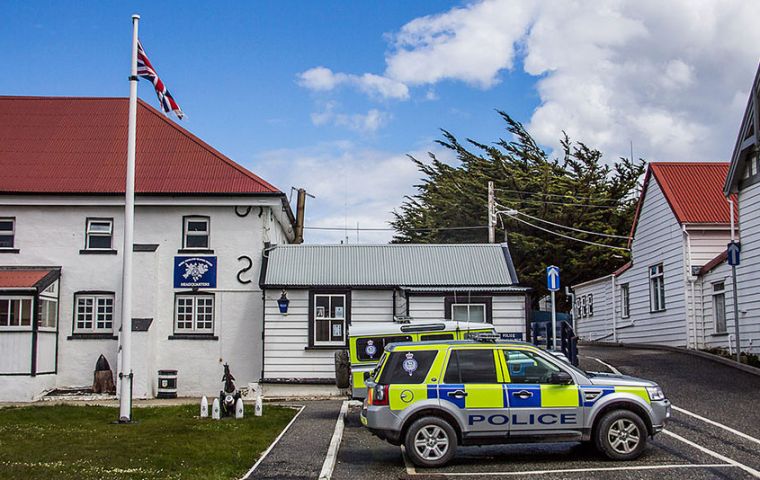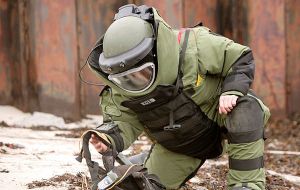MercoPress. South Atlantic News Agency
Argentine explosive devices from the Falklands' war found and destroyed in the proximity of Stanley
 Police received a call from someone who had discovered something suspicious on the road beyond Stanley airport, heading to the Cape Pembroke lighthouse (Pic Wikimedia)
Police received a call from someone who had discovered something suspicious on the road beyond Stanley airport, heading to the Cape Pembroke lighthouse (Pic Wikimedia)  Explosive Ordnance Disposal unit (EOD) personnel were called to the scene and identified the object as a muzzle-propelled rifle grenade of Argentine manufacture
Explosive Ordnance Disposal unit (EOD) personnel were called to the scene and identified the object as a muzzle-propelled rifle grenade of Argentine manufacture The Falkland Islands weekly Penguin News reported this week that elements of the Royal Falkland Islands Police, the Fire Service and the military were in action following the discovery of two unexploded munitions in separate locations around the capital Stanley.
It was later confirmed that the unexploded munitions, and neutralized, dated back to the time of the Argentine invasion of the Falklands. One of the many testimonies of the 1982 conflict which still remain in the Islands such as the minefields planted by the retreating invading forces.
At midday last Tuesday the police received a call from a member of the public who had discovered something suspicious on the road beyond Stanley airport, heading to the Cape Pembroke lighthouse.
Personnel from the military Explosive Ordnance Disposal unit (EOD) were called to the scene and were able to identify the object as a muzzle-propelled rifle grenade of Argentine manufacture.
With the Stanley Fire Brigade also in attendance, the device was made safe by means of sand bags and was detonated in a controlled manner at 4.10pm During the whole of this operation, the Cape Pembroke road had to be closed to the general public.
Normally this would be no great inconvenience, but as luck would have it, reports that whales were visible from Cape Pembroke on that day, had increased the number of the general public hoping to use it.
Sadly, their patience had to be extended further when a second suspicious object was reported by workmen from Morrisons Ltd, working near the Training Centre on Sapper Hill. This item when examined by EOD turned out to be an Argentine Anti-Aircraft round.
This second device was transported by EOD, under police escort, to the site of the earlier detonation on Cape Pembroke, where it was exploded at 6pm. Following this controlled action where, as in the previous case, a 200m safety perimeter was maintained, the would-be whale watchers were once again at liberty to use the road.
RFIP Sergeant Alex Douglas, who provided Penguin News with the details of these events, thanked the public for their patience on this occasion and praised the members of the community who had rung in to report their suspicions.
Despite the passage of 37 years, these types of devices are still around, still potentially dangerous and should be treated with extreme caution and reported.




Top Comments
Disclaimer & comment rules-

-

-

Read all comments@DemonTree
May 10th, 2019 - 11:32 am +3Could be a lot worse than a couple of rifle grenades. Did you hear the horror story about the RAF Scampton gate guardian (for those in countries that don't do it, they take a decommissioned vehicle/cannon, strip anything that might be useful off of it, weld the doors shut and put them on plinths outside the main gates)?
Just after WW2 the Scampton guard was an Avro Lancaster heavy bomber that had flown from there complete with a Grand Slam bomb casing.
In the late 1950s the council were widening the road in front of Scampton's main gate, so they needed to move the guardians temporarily. The plane was no problem, it still had it's wheels, but the bomb casing proved too much for the small crane that the council had.
Turns out that somehow they'd used a live 22,000 lb bomb, which had been parked out in front of the gate for over a decade being occasionally painted.
https://www.youtube.com/watch?v=Cun-LZvOTdw
May 10th, 2019 - 10:01 am -137 years is nothing, they're still finding unexploded German bombs from WWII in Britain, and Allied bombs in Germany.
Wow, that's crazy. Can't believe they didn't bother checking before putting it on display.
May 10th, 2019 - 02:16 pm -1Commenting for this story is now closed.
If you have a Facebook account, become a fan and comment on our Facebook Page!